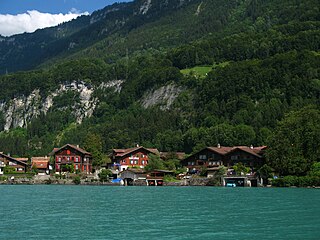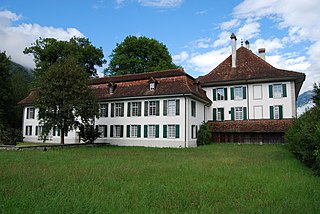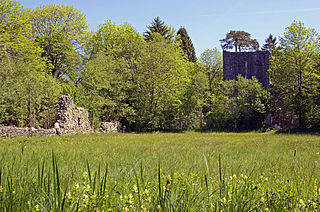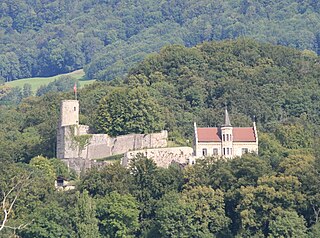
The canton of Bern or Berne is the second-largest of the 26 Swiss cantons by both surface area and population. Located in west-central Switzerland, it borders the canton of Jura and the canton of Solothurn to the north. To the west lie the canton of Neuchâtel, the canton of Fribourg and canton of Vaud. To the south lies the canton of Valais. East of the canton of Bern lie the cantons of Uri, Nidwalden, Obwalden, Lucerne and Aargau.

Iseltwald is a village and municipality on the southern shore of Lake Brienz in the Bernese Oberland region of Switzerland. Politically, the municipality is located in the Interlaken-Oberhasli administrative district of the canton of Bern.

The Bernese Oberland is the higher part of the canton of Bern, Switzerland, in the southern end of the canton, and one of the canton's five administrative regions.

Oberland was the name of a canton of the Helvetic Republic (1798–1803), corresponding to the area of the Bernese Oberland, with its capital at Thun.

Ringgenberg is a village and a municipality in the Interlaken-Oberhasli administrative district in the canton of Bern in Switzerland. Besides the village of Ringgenberg, the municipality also includes the village of Goldswil.

Wilderswil is a village and a municipality in the Interlaken-Oberhasli administrative district in the canton of Bern in Switzerland.

Schwanden bei Brienz is a municipality in the Interlaken-Oberhasli administrative district in the canton of Bern in Switzerland.

Niederried bei Interlaken is a municipality in the Interlaken-Oberhasli administrative district in the canton of Bern in Switzerland.

Oberried am Brienzersee is a municipality and village in the Interlaken-Oberhasli administrative district in the canton of Bern in Switzerland. Besides Oberried itself, the municipality includes the settlements of Dörfli and Ebligen.

Unspunnen Castle is a castle, now in ruins, located in the municipality of Wilderswil in the Bernese Highlands of Switzerland. The castle, likely constructed in the early 12th century, overlooks the city of Interlaken.

Oberhofen Castle is a castle in the municipality of Oberhofen of the Canton of Bern in Switzerland. It is a Swiss heritage site of national significance.

Interlaken Monastery was a convent of the Augustinian Canons Regular from about 1133 until 1528 at Interlaken in the canton of Bern in Switzerland. It is a Swiss heritage site of national significance.

The ruins of Grünenberg Castle, Schnabelburg Castle and Langenstein Castle are a complex of three interconnected castles on a hill above the municipality of Melchnau in the canton of Bern in Switzerland. The three castles formed the center of power of the Barons of Grünenberg in the Oberaargau region during the High Middle Ages.

Allmendingen Castle is a castle in the municipality of Allmendingen of the canton of Bern in Switzerland.

Weissenau Castle is a ruined castle in the municipality of Unterseen of the Canton of Bern in Switzerland. It is a Swiss heritage site of national significance.

Oberer Mannenberg Castle is a ruined castle in the municipality of Zweisimmen of the canton of Bern in Switzerland. It is a Swiss heritage site of national significance.

Brandis Castle is the ruin of a hill fort from the 13th century. It stands in the Swiss municipality of Lützelflüh in the Canton of Bern above the village Lützelflüh on a rocky outcrop. Today, only the ruins and the moat are still visible.

Bipp Castle is a partially ruined castle in the municipality of Oberbipp of the Canton of Bern in Switzerland.

Weissenburg Castle is a ruined castle in the municipality of Därstetten of the Canton of Bern in Switzerland.

Thurnen is a municipality in the Bern-Mittelland administrative district in the canton of Bern in Switzerland. On 1 January 2020 the former municipalities of Kirchenthurnen, Lohnstorf and Mühlethurnen merged to form the new municipality of Thurnen.





















